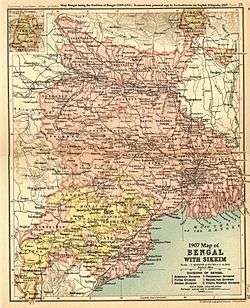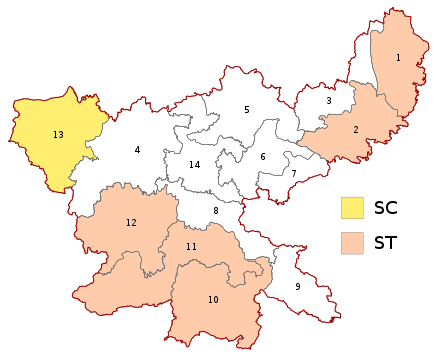Rajmahal
| Rajmahal | |
|---|---|
| city | |
 Rajmahal Location in Jharkhand, India  Rajmahal Rajmahal (India) | |
| Coordinates: 25°03′N 87°50′E / 25.05°N 87.84°ECoordinates: 25°03′N 87°50′E / 25.05°N 87.84°E | |
| Country |
|
| State | Jharkhand |
| District | Sahibganj |
| Population (2001) | |
| • Total | 17,974 |
| Languages | |
| • Official | Hindi |
| Time zone | UTC+5:30 (IST) |
| Vehicle registration | JH |
Rajmahal is a city and a notified area in Sahibganj district in the Indian state of Jharkhand. Rajmahal is the only sub-divisional town in Sahibganj district.
History

Neel-kothi is a historical place and it is located at the heart of the city of Rajmahal. It was built by Englishman on 24 September 1796 to process Neel (Indigo) used for dying cotton cloth; Then British government was ruling Rajmahal.It is an historic town situated on the west bank of the Ganges, and located in the hills known as Damin-i-koh during the Muslim rule. The hills run north-south for 193 km from Sahebganj to Rampurhat. The earlier name of the place was Agmahal. Man Singh, on his return from the conquest of Orissa in 1592, named it Rajmahal. On 9 November 1595, Man Singh laid the foundations of a new capital of Bengal Subah there and named it Akbarnagar, after Akbar, the emperor. There is a Historic Place called Sanghi Dalan. Sanghi Dalan is a historical place and it is located at the heart of the city of Rajmahal. Sangi Dalan is the remains of a palace, which was constructed by Raja Maan Singh. The palace was made up of marbles. The palace was built during the time period between 1580 and 1600 A.D. This place is at the walking distance from station. It is said that for the matter of safety queens used to walk 12 km through an underground pass from Jama Masjid to here for the sake of taking bath in river Ganga. But instead of preserving those underground tunnels they were completely closed under ignorance of the admin. The place is changed to a small park removing remain-ants of the structure. But still the sculptures and black stone entrance impart the essence of architecture of those times. This structure is stretch over a length of 300 m at the bank of river Ganga. In the absence of its own administrative buildings the government has been using these monuments as civil court, 'Rajmahal police station' and 'Rajmahal jail'. So it was not possible for a normal citizen to visit the whole structure. But recently civil court has moved to a new building. The place also contains few graves of the officers who rule over the city at british times clearly mentioning their name, period and post.[1]
Demographics
As of 2001 India census,[2] Rajmahal had a population of 17,974. Males constitute 52% of the population and females 48%. Rajmahal has an average literacy rate of 48%, lower than the national average of 59.5%: male literacy is 55%, and female literacy is 39%. In Rajmahal, 19% of the population is under 6 years of age.
Administration
Assembly segments
Presently, Rajmahal Lok Sabha constituency comprises the following six Vidhan Sabha (legislative assembly) segments:[3]
| Constituency number | Name | Reserved for (SC/ST/None) | District |
|---|---|---|---|
| 1 | Rajmahal | None | Sahebganj |
| 2 | Borio | ST | Sahebganj |
| 3 | Barhait | ST | Sahebganj |
| 4 | Litipara | ST | Pakur |
| 5 | Pakaur | None | Pakur |
| 6 | Maheshpur | ST | Pakur |
Members of Parliament
The Rajmahal (Lok Sabha constituency) is centered around the city.
- 1957: Paika Murmu, Indian National Congress
- 1962: Iswar Marandi, Indian National Congress
- 1967: Iswar Marandi, Indian National Congress
- 1971: Iswar Marandi, Indian National Congress
- 1977: Anthony Murmu, Janata Party
- 1980: Seth Hembram, Indian National Congress
- 1984: Seth Hembram, Indian National Congress
- 1989: Simon Marandi, Jharkhand Mukti Morcha
- 1991: Simon Marandi, Jharkhand Mukti Morcha
- 1996: Thomas Hansda, Indian National Congress
- 1998: Som Marandi, Bharatiya Janata Party
- 1999: Thomas Hansda, Indian National Congress
- 2004: Hemlal Murmu, Jharkhand Mukti Morcha
- 2009: Devidhan Besra, Bharatiya Janata Party
- 2014: Vijay Kumar Hansdak, Jharkhand Mukti Morcha
See also
Notes
- ↑ Sarkar, Jadunath (1984). A History of Jaipur, c. 1503-1938, New Delhi: Orient Longman, ISBN 81-250-0333-9, p.81
- ↑ "Census of India 2001: Data from the 2001 Census, including cities, villages and towns (Provisional)". Census Commission of India. Archived from the original on 2004-06-16. Retrieved 2008-11-01.
- ↑ "Parliamentary Constituency". Chief Electoral Officer, Jharkhand website. Archived from the original on 26 February 2012.
